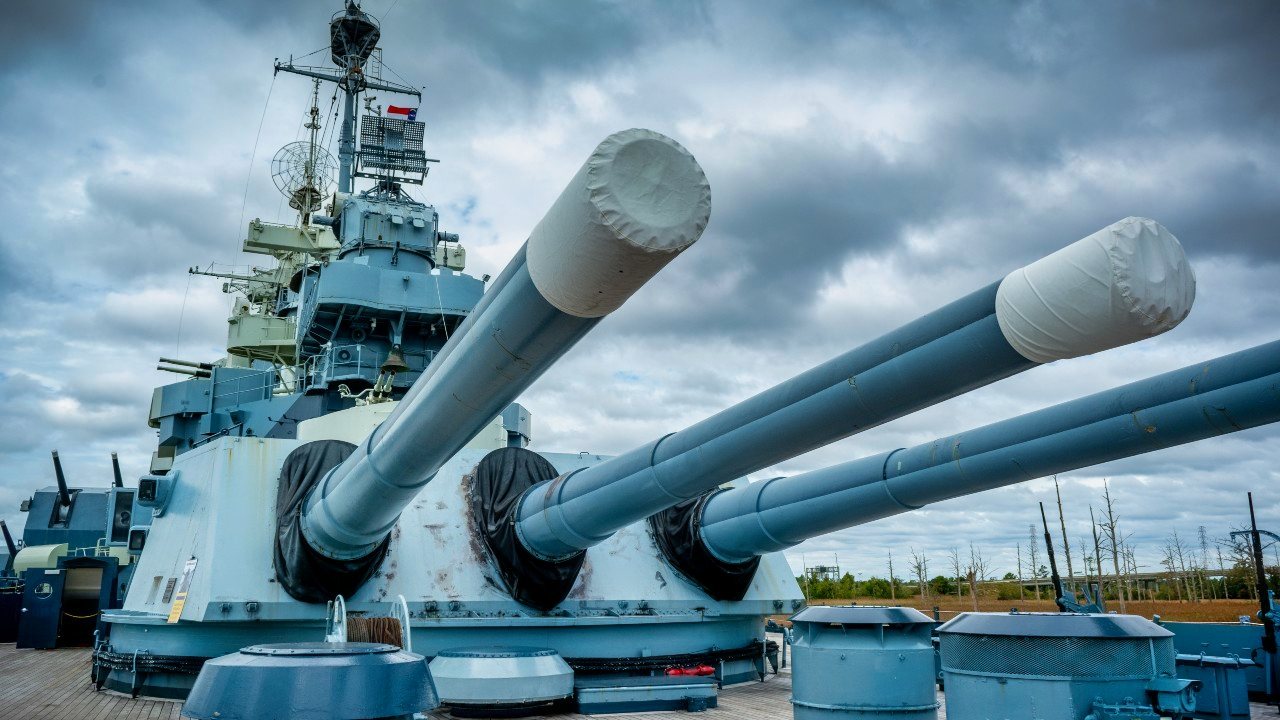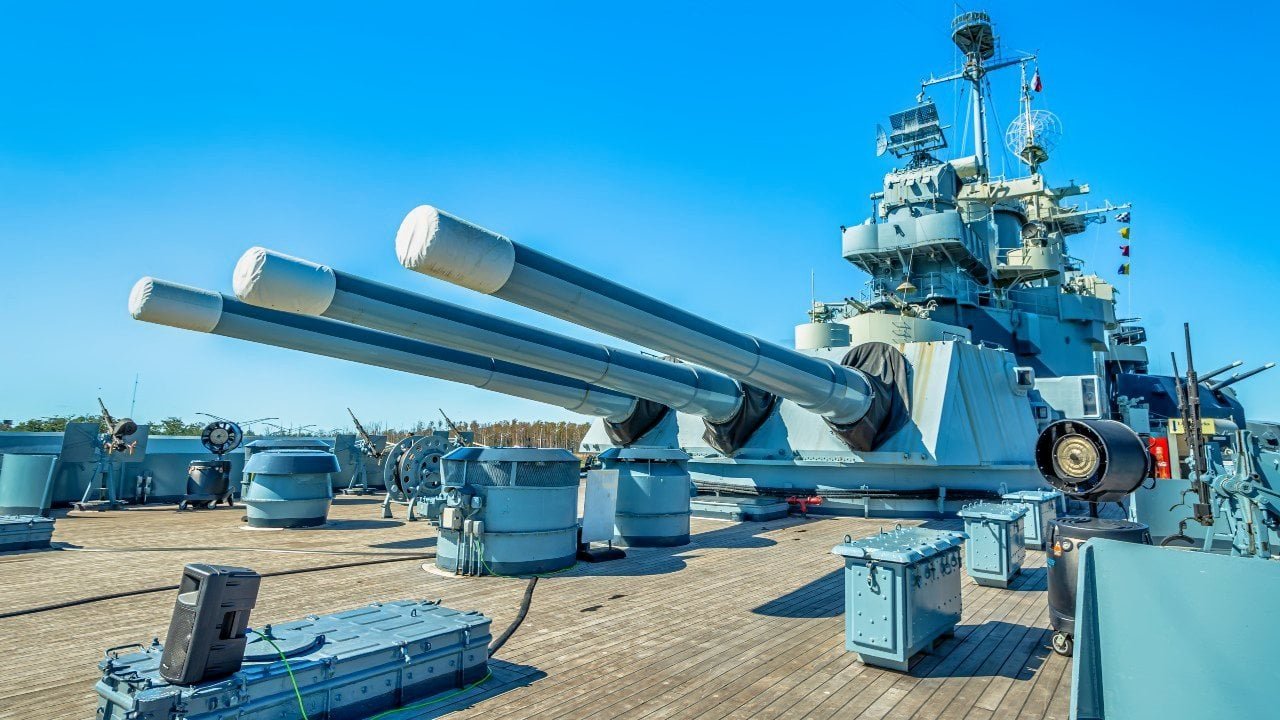What You Need to Know: The USS North Carolina (BB-55), the first of the North Carolina-class fast battleships, played a pivotal role in WWII, showcasing advanced firepower and speed.

-Designed with nine 16-inch guns and twenty 5-inch dual-purpose guns, this 35,000-ton battleship operated effectively in both the Atlantic and Pacific theaters.
-It supported U.S. ground forces at Guadalcanal and proved vital in the Battle of the Eastern Solomons.
-Despite sustaining damage at the Battle of Santa Cruz, the resilient North Carolina remained operational.
-Decommissioned in 1947, the ship is now preserved as a museum in North Carolina, symbolizing American strength and WWII legacy.
USS North Carolina: WWII’s Iconic Fast Battleship with Firepower to Spare
Launched in 1940 and commissioned a year later, the USS North Carolina (BB-55) was the first of the North Carolina-class fast battleships (a total of two were built). Initially designed under the constraints of the 1922 Washington Naval Treaty between the United States, the British Empire, and the Empire of Japan, the North Carolina-class fast battleships were meant to exceed the capabilities of her potential rivals.
In fact, her displacement of around 35,000 tons when fully loaded was a testament to the ways in which the treaty’s signatories were playing fast-and-loose with the treaty itself (with Japan being the worst violator of these standards).
The Specs
Possessing nine, 16-inch guns in three triple turrets, this battleship was a significant upgrade from the usual 14-inch guns found on previous U.S. Navy battleships. These bad boys could hurl 2,700-pound shells over a distance of 20 miles, giving this battleship quite a punch. Beyond those turrets were the twenty, five-inch dual-purpose guns for anti-aircraft and secondary surface combatants. The presence of these guns reflected the growing importance of defending against air attacks in naval warfare.
And she lived up to her classification as a “fast battleship.” Being able to reach up to 28 knots, the USS North Carolina was among the fastest battleships in the world at the time of her commissioning. In fact, these battleships were meant to operate alongside aircraft carriers and keep pace with faster fleet elements.
North Carolina had significant combat deployments in both the Atlantic and Pacific Theaters of World War II. Initially stationed in the Atlantic, she was meant to be a deterrent against the German Kriegsmarine (navy). It is widely believed that the presence of the North Carolina significantly contributed to the strategic balance of power in the Atlantic during the early war years.
Helping to Dim the Empire of the Rising Sun
In 1942, however, the North Carolina was transferred to the Pacific Theater where she fought in the Guadalcanal campaign, providing key fire support to U.S. ground forces. At the Battle of the Eastern Solomon Islands, North Carolina’s presence contributed to the victory’s broader strategic success. She was a key player there, in fact, whose presence was decisive because of the firepower she could bring to bear.
At the Battle of the Santa Cruz Island in October 1942, North Carolina was hit by a Japanese dive bomber. The great battleship, despite suffering significant damage from the Japanese attack, remained operational—proving her resilience and worth to a Navy that was coming to favor the aircraft carrier.
Indeed, the North Carolina came to symbolize American prestige and power during the war. She evolved from a direct combatant to providing bombardment support for forces wading ashore. North Carolina provided air defense as well as fleet protection, reflecting a wider evolution in the nature of naval strategy in WWII.
Gone But Never Forgotten
When the war ended, and both aircraft carriers and missiles became a key factor in modern warfare, the role of battleships, like the North Carolina, faded away. The fast battleship was decommissioned in 1947. But her legacy lives on today. She was donated to the state of North Carolina, the state after which she is named. Today, one can visit the North Carolina as it is a museum ship open to the public.
The fact that the Navy opted to make her a museum ship rather than to break her down for scrap, like they did with so many other legendary WWII era warships, should prove to you just how important and iconic of a battleship the USS North Carolina was. She was an essential player in the history of our country.
We must never forget the service she and her legendary crew performed in helping to defeat some of America’s greatest foes in WWII.
About the Author:
Brandon J. Weichert, a National Interest national security analyst, is a former Congressional staffer and geopolitical analyst who is a contributor at The Washington Times, the Asia Times, and The-Pipeline. He is the author of Winning Space: How America Remains a Superpower, Biohacked: China’s Race to Control Life, and The Shadow War: Iran’s Quest for Supremacy. His next book, A Disaster of Our Own Making: How the West Lost Ukraine, is available for purchase wherever books are sold. Weichert can be followed via Twitter @WeTheBrandon.
